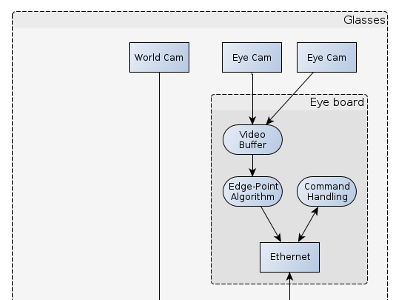About Eyeris
The Problem
Mobile Eye-Tracking glasses are needed to be able to determine where one is looking at any given point in time. There are currently no mobile solutions that track both eyes, which would allow for 3D eye-tracking. Also, very few mobile solutions allow real-time streaming. This would allow multiple people to watch a study as it is being conducted rather than analyzing the data afterwards. There exhibits a need to stream this over WiFi networks so that this is compatible with multiple platforms and applications.
The Glasses
Expand Image
In order to accomplish the goal of streaming outward facing video with eye tracking data, we will be using two USB IR (Infrared) cameras -- each facing an eye -- to determine where the user is looking by calculating the convergence of the users’ two eyes. The edge detection algorithm for each eye will be done on-board in the user’s backpack. The edge points can then be sent to a server wirelessly for the ellipse fitting algorithm. The server then embeds the direction into the video feed of the point-of-view, outward facing high definition camera and is streamed wirelessly to the user.
The solution will mainly be used in the C6 and Mirage 3D virtual environments which will be indoors and have strong WiFi connections. Ideally, our solution will be easy to adapt to a regular pair of glasses to be used outdoors or anywhere else given that there is strong WiFi for streaming.
The Work Flow of Our Solution
The device will stream video via WiFi to the client's computer. The client can connect to the device locally to run calibration and access recorded video.
Expand Image
The client software will display the outward facing video feed of what the wearer is seeing with a cross-hair of where the user is looking on top of the video feed, as well as the depth and accuracy rating. The client software will have the ability to provide calibration. The client software will also provide feedback about which eyes are being effectively tracked. There will also be numerous value/slider bars to fine-tune the eye tracking algorithm to the current user. If the client software loses connection to the eye tracking head gear, the client software will continually attempt to re-establish a connection to resume streaming. The glasses will save any footage and data on a hard drive that was not streamed.

